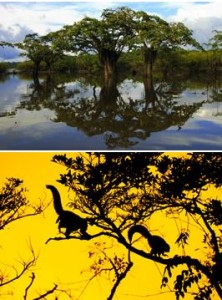Created the same year as Yasuní, 1979, the Cuyabeno Wildlife Reserve has an area of 655 hectares (1,639,452 acres), and lies between the San Miguel and the Aguarico Rivers. Several spectacular lakes offer a very different vision of the forest, with truly beguiling flooded environments (trees look as if they were being born from the water), that alone make a trip out to these frontier jungle realms worth while (including amazing water phenomena such as oxbow lakes created from the changing courses of Amazonian rivers). But the wildlife is equally as impressive and attractive, boasting a similar extreme biodiversity (perhaps only minimally inferior) as its neighboring Yasuní counterpart.
Amazonian lakes are mostly blackwater lakes, like Zancudococha, Delfincocha (a total of 13 are found in Cuyabeno), where caiman and pink river dolphins can be found, as well as numerous fish species. The blackwater lake and river systems, especially when reaching enormous bodies of jet-black water, are truly mesmerizing. The Grande, Cangueno, Lagartococha, Delfincocha, Redondococha and Zancudococha lakes are among the most beautiful tropical draining lagoons of the Aguarico River. The Cuyabeno Wildlife Reserve is known to protect 500 bird species, 100 mammal species, 247 fish species and 52 reptile species.
Among other sites, the Cuyabeno Wildlife Reserve will be explored by passengers going aboard the M/V Manatee Amazon Explorer and soon aboard the M/V Anakonda Amazon River Cruise which starts its operation on July 17th 2013.
Advantage Travel, www.advantagecuador.com; M/V Manatee Amazon Explorer, www.manateeamazonexplorer.com; M/V Anakonda Amazon River Cruise, www.anakondaamazoncruises.com

